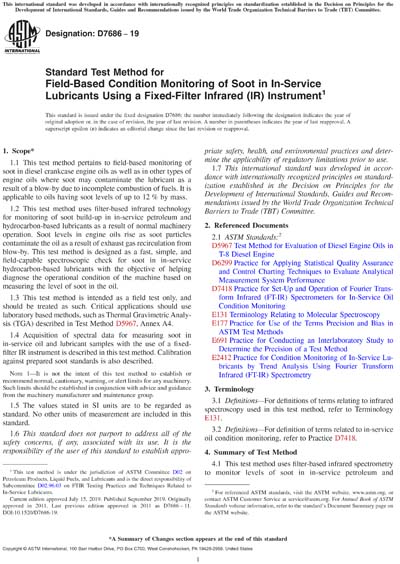Historical
ASTM D7686-19
Standard Test Method for Field-Based Condition Monitoring of Soot in In-Service Lubricants Using a Fixed-Filter Infrared (IR) Instrument
1.1 This test method pertains to field-based monitoring of soot in diesel crankcase engine oils as well as in other types of engine oils where soot may contaminate the lubricant as a result of a blow-by due to incomplete combustion of fuels. It is applicable to oils having soot levels of up to 12 % by mass.
1.2 This test method uses filter-based infrared technology for monitoring of soot build-up in in-service petroleum and hydrocarbon-based lubricants as a result of normal machinery operation. Soot levels in engine oils rise as soot particles contaminate the oil as a result of exhaust gas recirculation from blow-by. This test method is designed as a fast, simple, and field-capable spectroscopic check for soot in in-service hydrocarbon-based lubricants with the objective of helping diagnose the operational condition of the machine based on measuring the level of soot in the oil.
1.3 This test method is intended as a field test only, and should be treated as such. Critical applications should use laboratory based methods, such as Thermal Gravimetric Analysis (TGA) described in Test Method D5967, Annex A4.
1.4 Acquisition of spectral data for measuring soot in in-service oil and lubricant samples with the use of a fixed-filter IR instrument is described in this test method. Calibration against prepared soot standards is also described.
Note 1: It is not the intent of this test method to establish or recommend normal, cautionary, warning, or alert limits for any machinery. Such limits should be established in conjunction with advice and guidance from the machinery manufacturer and maintenance group.
1.5 The values stated in SI units are to be regarded as standard. No other units of measurement are included in this standard.
1.6 This standard does not purport to address all of the safety concerns, if any, associated with its use. It is the responsibility of the user of this standard to establish appropriate safety, health, and environmental practices and determine the applicability of regulatory limitations prior to use.
1.7 This international standard was developed in accordance with internationally recognized principles on standardization established in the Decision on Principles for the Development of International Standards, Guides and Recommendations issued by the World Trade Organization Technical Barriers to Trade (TBT) Committee.
Content Provider
ASTM International [astm]






